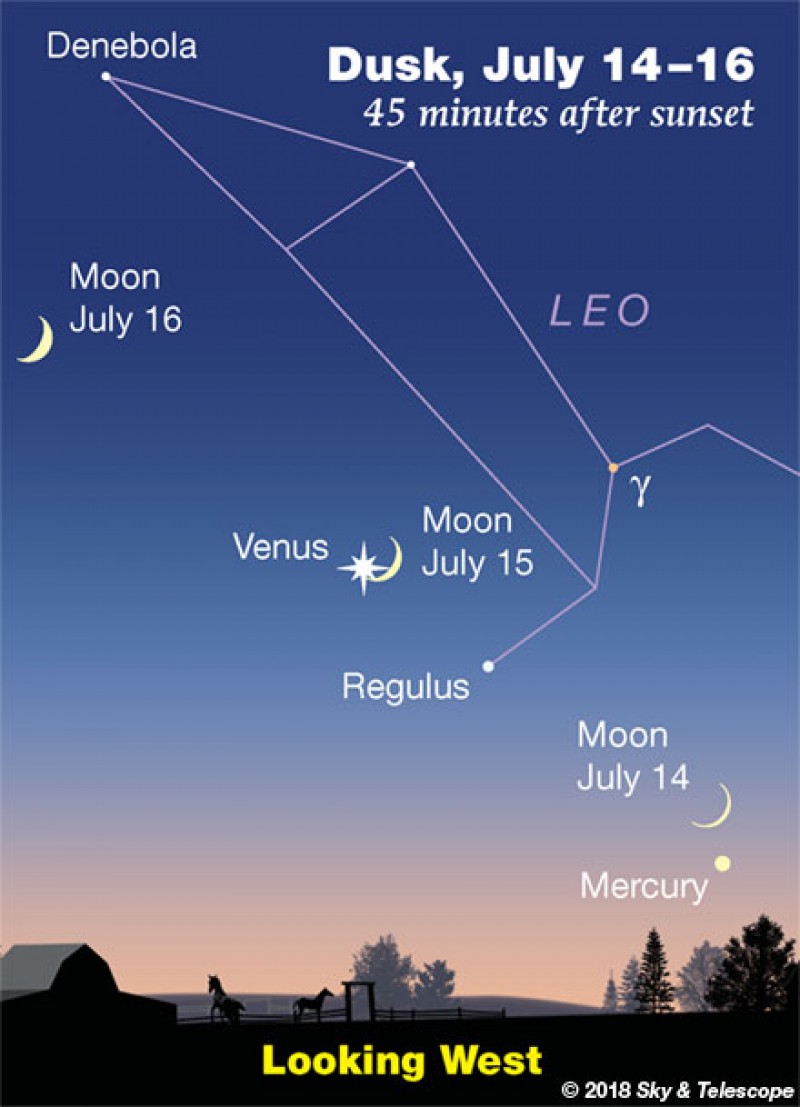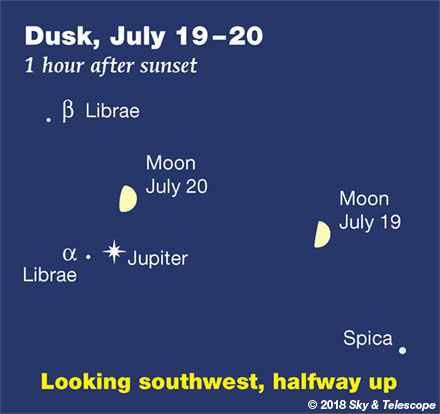Friday, July 13
• Cassiopeia is now well past its annual bottoming out due north. Look for its W pattern climbing low in the north-northeast after dark. The farther north you live, the higher it will be.
Saturday, July 14
• As twilight fades, see if you can catch the Moon over Mercury very low in the west, well to the lower right of Venus as shown here. Your best view may be about 45 minutes after sunset.
• One hour after sunset, as twilight fades further and the stars are coming out, you'll find the two brightest stars of summer, Vega and Arcturus, about equally near the zenith: Vega toward the east, shining very pale bluish white, and Arcturus toward the southwest, pale yellow-orange.
Sunday, July 15
• Moon and Venus: a lovely couple!Hanging dramatically in the west during twilight will be quite the eye-catcher: Venus and the crescent Moon closely paired. How closely depends on where you are. Seen at the time of dusk in North America's eastern time zone, they’ll appear about 2° apart. Seen from the West, they’ll be less than 1° apart.
Also, look carefully a little to their lower right for Regulus twinkling away. It’s slightly less than 1% as bright as Venus. You may also be able to catch Mercury much farther lower right. A line from Venus through Regulus points straight to Mercury; binoculars will help.
Monday, July 16
• Now the crescent Moon in twilight shines upper left of Venus. Its sunlit bulge points down almoststraight toward Venus — and, as always, exactly straight toward the Sun.

Tuesday, July 17
• Starry Scorpius is sometimes called "the Orion of Summer" for its brightness and its prominent red supergiant (Antares in the case of Scorpius, Betelgeuse for Orion). But Scorpius passes a lot lower across the southern sky on July nights than Orion does in winter (for those of us at mid-northern latitudes.) That means it has only one really good evening month: July.
Catch Scorpius due south just after dark now, before it starts to tilt lower toward the southwest. It's full of deep-sky objects to hunt out with a good sky atlas and binoculars or a telescope.
Wednesday, July 18
• The Moon at nightfall shines to the upper right of Spica. Look very high above the Moon for brighter Arcturus. Far to the right of Arcturus is the Big Dipper.
• The Cygnus Milky Way is high in the east after dark and passes overhead late at night. The Heart Star of Cygnus, and the center of the Northern Cross, is 2nd-magnitude Sadr (Gamma Cygni), smack in the Milky Way's midst. Binoculars will show the roughly heart-shaped ring of faint stars around and including it.
Thursday, July 19
• First-quarter Moon (exact at 3:52 p.m. Eastern Daylight Time). The Moon shines in the southwest at dusk, with Spica to its lower right and Jupiter to its left. Draw a line about twice as far onward from Jupiter and you'll reach Antares, passing Delta Scorpii along the way.
Friday, July 20
• The waxing gibbous Moon shines over Jupiter this evening. Left of Jupiter by just 2° is the wide binocular double star Alpha Librae, magnitudes 2.8 and 5.1.
The Moon is 1.3 light-seconds distant from us, Jupiter is 44 light-minutes in its background, and the two stars of Alpha Librae are 77 light-years behind them.
Saturday, July 21
• Jupiter and little Alpha Librae shine lower right of the Moon this evening. To the Moon's lower left is Antares, with other stars of upper Scorpius scattered around.
